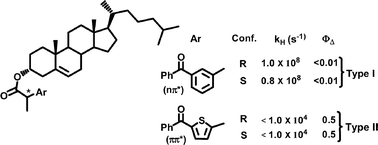Cholesterol–diaryl ketone stereoisomeric dyads as models for “clean” type I and type II photooxygenation mechanisms†
Abstract

* Corresponding authors
a
Departamento de Química-Instituto de Tecnología Química UPV-CSIC. Universidad Politécnica de Valencia, Camino de Vera s/n, Apdo 22012, Valencia, Spain
E-mail:
mmiranda@qim.upv.es
Fax: +34 963877809
Tel: +34 963877807
b Laboratori de Química Farmacèutica (Unitat Associada al CSIC), Universidad de Barcelona, Avda. Diagonal 643, Barcelona, Spain

 Please wait while we load your content...
Something went wrong. Try again?
Please wait while we load your content...
Something went wrong. Try again?
I. Andreu, I. M. Morera, F. Boscá, L. Sanchez, P. Camps and M. A. Miranda, Org. Biomol. Chem., 2008, 6, 860 DOI: 10.1039/B718068C
To request permission to reproduce material from this article, please go to the Copyright Clearance Center request page.
If you are an author contributing to an RSC publication, you do not need to request permission provided correct acknowledgement is given.
If you are the author of this article, you do not need to request permission to reproduce figures and diagrams provided correct acknowledgement is given. If you want to reproduce the whole article in a third-party publication (excluding your thesis/dissertation for which permission is not required) please go to the Copyright Clearance Center request page.
Read more about how to correctly acknowledge RSC content.
 Fetching data from CrossRef.
Fetching data from CrossRef.
This may take some time to load.
Loading related content
